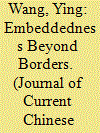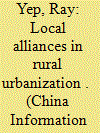|
|
|
Sort Order |
|
|
|
Items / Page
|
|
|
|
|
|
|
| Srl | Item |
| 1 |
ID:
156521


|
|
|
|
|
| Summary/Abstract |
The devastating 2008 Wenchuan earthquake unfolded the co-evolution of a proactive civic engagement and extensive application of web-based information and communication technologies (ICTs) in China’s disaster response. However, existing literature has not yet sufficiently examined how ad hoc web-based voluntary participation has led to long-term development of digital disaster management in China in the wake of the Wenchuan earthquake of 2008. The present article addresses this gap by focusing on one specific type of ICT-mediated civic effort, crisis crowdsourcing, and presenting newly collected empirical evidence from relief work in the 2008 Wenchuan, 2010 Yushu, and 2013 Lushan earthquakes. This article examines the emergence of a broad-based digitally enabled civic participation in disaster response and its more general political implications. The main findings of this study suggest that web-based ICTs have not only enabled the relatively weak and episodic social actors to overcome constraints on information, fundraising, organizational development and to achieve collective development in a field historically dominated by the state, but also facilitated the evolution of a parallel disaster management system with agenda, skills and expertise independent of the state.
|
|
|
|
|
|
|
|
|
|
|
|
|
|
|
|
| 2 |
ID:
189902


|
|
|
|
|
| Summary/Abstract |
The internationalisation of Chinese non-governmental Organisations (NGOs) is an emerging phenomenon. As new international development actors, how independent are Chinese NGOs from the Chinese state? Based on interviews with eighteen Chinese NGOs and an analysis of secondary sources, the study finds that the internationalisation of Chinese NGOs is variegated rather than solely state-led. The state is not closely involved in much of the internationalisation processes of a majority of Chinese NGOs. However, all Chinese NGOs with overseas operations avoid overstepping a political boundary that is tacitly understood by both NGOs and the state. To explain the duality of both uniformity and diversity among Chinese NGOs, this study develops an embeddedness framework that disaggregates state influences into a primary layer of systemic regulatory guidance that affects all Chinese NGOs, and a secondary layer of influence over NGOs’ operations (initiation, financing, and implementation), within which the varying levels of governmental influence upon different NGOs lie.
|
|
|
|
|
|
|
|
|
|
|
|
|
|
|
|
| 3 |
ID:
173250


|
|
|
|
|
| Summary/Abstract |
The relocation of peasants to high-rise buildings is the latest strategy deployed to feed the insatiable hunger for land in China. To free up more land for construction, Chinese peasants are encouraged to abandon their traditional homes and move into newly built high-rise modern apartments. A central feature of this distinctive form of rural urbanization is the transferability of land development rights across the rural–urban divide. Like most policy initiatives in Chinese economic reforms, variations and improvisation in implementation are found across local administrations. Such local disparities carry major implications for rural governance. This article compares and evaluates the experience of local governments in Chongqing and Nantong. Local governments in these two localities face both opportunities and constraints in integrated urban–rural development, a situation which has contributed to contrasting relocation patterns, and consequently variations in intergovernmental relationships at local levels. Enjoying the privilege of experimenting with the ‘land bill’ (地票) system, local governments in Chongqing have more leeway to stake their claims and are thus in a better position to maintain their authority. In the Nantong case, however, the more hands-on approach of the prefecture deprives lower administrative levels of flexibility to pursue their interests. This contrast in the policy process leads to different patterns of collaboration between levels of government at the grass roots in the two localities, which may also have a long-term impact on the exercise of authority at the community level.
|
|
|
|
|
|
|
|
|
|
|
|
|
|
|
|
| 4 |
ID:
189977


|
|
|
|
|
| Summary/Abstract |
Although there may be disagreement about the consequences of technology, such as the Internet, on Chinese philanthropy, there is consensus that giant tech companies have profoundly reshaped the field. One outcome is that this has led to the rise of digital philanthropy. The extant studies on the impact of the Internet on philanthropic practices tend to be limited to investigations of a specific platform (e.g. Weibo), while overlooking the heterogeneity of tech-empowered digital philanthropy in China. This study is an introduction to the diversity and the platformization of digital philanthropy. We use a snowball sampling online survey (n = 2132) to examine people’s attitudes towards digital philanthropy to understand user perceptions of some of the most common digital philanthropy platforms and products. The sample captures more educated mobile phone users already active on digital platforms. Based on the results, we categorize and discuss the three most mentioned types of digital philanthropy products: event-based products, issue-based products, and gamified mini-programs. We provide some insight on how these philanthropic products are engineered to blur the boundaries between online and offline activities to leverage tech companies’ mega platforms. The platformization of digital philanthropy has potential consequences for the evolving state–business–society relationship.
|
|
|
|
|
|
|
|
|
|
|
|
|
|
|
|
|
|
|
|
|